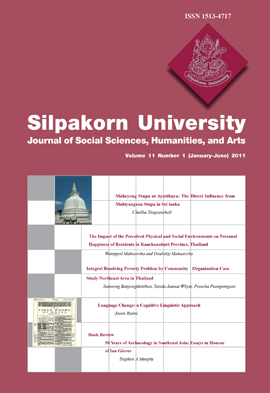Language Change: a Cognitive Linguistic Approach
Main Article Content
Abstract
Introduction
This paper considers an alternative approach to analyzinglanguage change: cognitive linguistic evidence. In doing so, fundamentalcognitive linguistic theories of embodiment (Lakoff and Johnson1999), figure and ground (Ungerer and Schmid 1996:156-204), thedominant (Jakobson 1985:25-28) and image schema (Langacker 1986,1987, 1991) will be utilized as a backbone for explaining languagechange. The paper starts by detailing the instruments that underpin theinvestigation. Subsequently, two versions of The Lord’s Prayer willbe presented with an explanation of their suitability as test subjectsfor language change. The core of the paper comprises of a cognitivelinguistic analysis of language change in The Lord’s Prayer between1611 and 1977, followed by a brief consideration of the widerimplications of cognitive linguistic approaches to language change. Insum, the paper aims to demonstrate that cognitive linguistics providesa methodology which can be productively used to study languagechange, as demonstrated by a cognitive linguistic analysis of changewithin The Lord’s Prayer over a 366 year period.
Downloads
Article Details
All rights reserved. Apart from citations for the purposes of research, private study, or criticism and review,no part of this publication may be reproduced, stored or transmitted in any other form without prior written permission by the publisher.
References
Burke, M. (2003) Literature as parable. In: Gavins, J. and Steen, G. Cognitive Poetics in Practice. New York: Routledge, pp.115-128.
Bybee, J. (2007) Diachronic Linguistics. In: Geeraerts, H., and Cuyckens, H. The Oxford Handbook of Cognitive Linguistics. Oxford: Oxford University Press, pp.945-987.
Canning, P. (2008) ‘the bodie and the letters both’: ‘blending’ the rules of early modern religion’, Language and Literature, 17: 187-204.
Fauconnier, G and Turner, M. (2002) The Way We Think: Conceptual Blending and the Mind’s Hidden Complexities. New York: Basic Books.
Freeborn, D. (2006) From Old English to Standard English, 3rd edition. Basingstoke: Palgrave.
Gavins, J. (2003) An exploration of the text worlds of Donald Barthelme’s Snow White. In: Gavins, J. and Steen, G. Cognitive Poetics in Practice. New York: Routledge, pp.129-144.
Gibbs, R. (2003) Prototypes in dynamic meaning construal. In: Gavins, J. and Steen, G. Cognitive Poetics in Practice. New York: Routledge, pp.27-40.
Hogg, R., and Denison, D. (2006) A History of the English Language. Cambridge: Cambridge University Press.
Jakobson, R. (1960) Closing statement: linguistics and poetics. In:, pp.48-54.
Johnson, M. (1987) The Body in the Mind: The Bodily Basis of Meaning, Imagination, and Reason. Chicago: University of Chicago Press.
Lakoff, G., and Johnson, M. (1999) Metaphors we live by. Chicago: University of Chicago Pres.
Langacker, R. W. (1986) ‘An Introduction to Cognitive Grammer’, Cognitive Science, 10: 1-40.
Langacker, R. W. (1987) Foundations of Cognitive Grammar i. California: Stanford University Press.Langacker, R. W. (1991) Foundations of Cognitive Grammar ii. California: Stanford University Press.
McMahon, A. M. S. (1994) Understanding Language Change. Cambridge: Cambridge University Press.
Stockwell, P. (2002) Cognitive Poetics: An Introduction. London: Routledge.
Talmy, L. (1978) Figure and ground in complex sentences. In: Greenberg, J. (ed.) Universals of Human Language (vol.4). Standford: Stanford University Press, pp.627-649.
Turner, M. (2006) ‘Compression and Representation’, Language and Literature, 15(1): 17-27.
Ungerer, F., and Schmid, H-J. (1996) An Introduction to Cognitive Linguistics. London: Longman.
Verhagen, A. (2007) Construal and Perspectivization. In: Geeraerts, H., and Cuyckens, H. The Oxford Handbook of Cognitive Linguistics. Oxford: Oxford University Press, pp.48-81.


